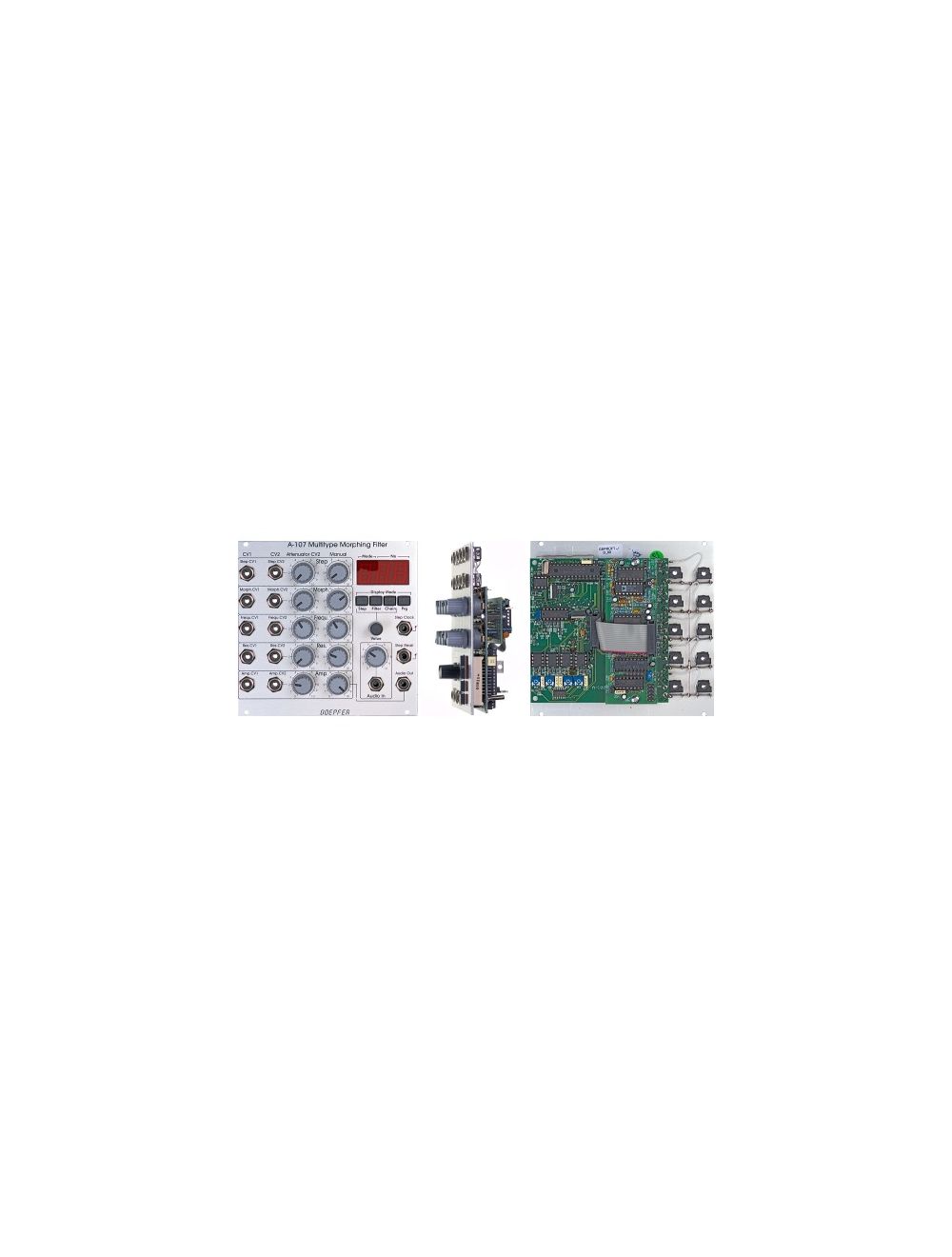Doepfer A-107 Multitype Morphing Filter
The Doepfer A-107 Multitype Morphing Filter is one of Doepfer's masterpieces. The biggest number of saveable, chainable filter-types available within one of Doepfer's fattest-sounding module!
The Doepfer A-107 Multitype Morphing Filter is one of Doepfer's masterpieces. The biggest number of saveable, chainable filter-types available within one of Doepfer's fattest-sounding module!
Module A-107 is a completely new voltage controlled filter that has available 36 filter types: different versions of low pass, high pass, band pass, notch, all pass and filters with new response curves that have no name up to now. The frequency response curves of the 36 filters available in the A-107 are shown in the graphics at the end of this page. The filters are organized in two groups of 18 filters each. The transition between different filter types within one group can be soft (morphing) or hard (switching). The filter was inspired by the ERWIK Musikelektronik Multimode Filter, which is based on the filter used in the Oberheim Matrix 12 resp. Xpander (thanks to Jesper Erwik Johansson for his assistance and permission to use his idea in our A-107 module).
The possibilities of the A-107 go far beyond these filter designs as a lot of new filter types are available and the transition between filters can be soft (morphing) or hard (switching) and the filters can be arranged in 64 different voltage controlled filter chains. The transistion between the different filter types is controlled by two parameters: Filter Step (marked Step at the front panel) Morphing Time (marked Morph at the front panel) For both parameters manual control, one CV input with attenuator and one CV input without attenuator are available. The 36 filter types can be arranged in filter chains (resp. filter sequencer or filter orders) so that this sequence of filters is passed through while the control voltage changes from 0...+5V.
Each chain consists of 32 steps. 64 filter chains can be programmed by the user and stored in the non-volatile memory of the module. The following controls are used to program the filter chains:
- Step: button to address the desired step (1...32) within the filter chain in combination with the value encoder
- Filter: button to select the filter number (1...36) that is assigned to the current step within the chain in combination with the value encoder
- Chain: button to select one of the filter chains (1...64) in combination with the value encoder
- Program: button to store the current filter chain in one of the non-volatile memories (1...64) in combination with the value encoder
- Value: endless rotary encoder to change the parameter selected with the buttons 3 digit Display (the first digit indicates of the current value shows Step "S", Filter "F" or Chain "C", the second and third digit display the number)
Additionally a "clocked" mode is available. This means that the steps of the currently selected filter chain are selected one after another. Each positive transition of the Clock signal calls up the next filter of the chain (jack socket marked Step Clock). A positive trigger at the Step Reset input (jack socket marked Step Reset) resets to the first filter of the current filter chain. This allows e.g. to switch between the filters of the currently selected filter chain in sync with a sequencer.
Of course the standard VCF controls are available: manual filter frequency control, one CV input with attenuator and one CV input without attenuator. In addition voltage controlled resonance with manual control, CV input with attenuator and CV control without attenuator are available.
For the filters of the first group (1...18) self-oscillation is possible, the filters of the second group (19...36) do not feature self-oscillation. On top of it a final VCA is available (even with manual control, CV input with attenuator and CV input without attenuator). The filter design is 100% analog (CEM filter chip). Only the morphing control and memory managing is carried out by a microcontroller.
Remark: Because of technical reasons the transition between the two filter groups (1...18, resp. 19...36) cannot be carried out soft as capacitors have to be switched. Soft transition (i.e. morphing) is possible only within the filter group (i..e. within the filters 1...18 or 19...36). Switching between filters causes a "click" if the filters are from different groups. For more detailed information please look at the English user's manual.






